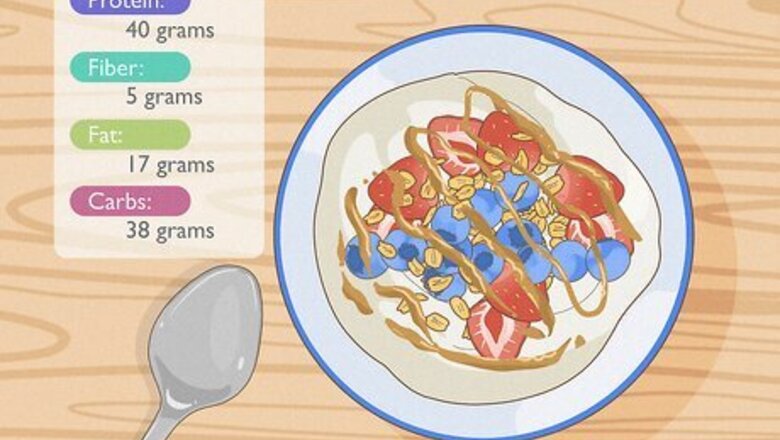
views
30 High-Protein High-Fiber Breakfast Ideas
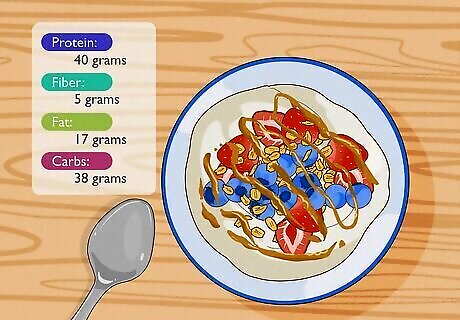
Greek Yogurt Bowl The combination of a serving of high-protein Greek yoghurt with 1 tablespoon (15 grams) of high-fiber peanut butter and ¼ cup (39 grams) of granola makes for a scrumptious yoghurt bowl. Toss in some of your favorite berries for a breakfast that will keep you going all day long. Protein: 40 grams Fiber: 5 grams Fat: 17 grams Carbs: 38 grams How to Customize: Mix in chocolate protein powder for an added boost and use any kind of toppings you like, from fruit and nuts to chocolate chips, coconut flakes, or honey. Meet the wikiHow Experts Monica Morris is an ACE certified personal trainer with over 15 years of fitness training experience. Pouya Shafipour, MD, MS, is a weight loss specialist who specializes in dietary, nutritional, behavioral, and exercise counseling. Kelly Gomez is a registered dietitian nutritionist who specializes in helping clients with their nutritional choices and overall health. Lisa Jubilee is a certified dietitian-nutritionist with over 20 years of experience in sustainable weight loss and disease prevention. Lyssandra Guerra is a certified nutrition & wellness consultant with over 5 years of nutrition coaching experience.
Overnight Oats Overnight oats are a terrific way to prepare your breakfast the night before, so you don’t have anything to do in the morning but enjoy it. Combine equal parts rolled oats and your milk of choice. Add half as much Greek yogurt, a touch of maple syrup or honey, and extras like chia seeds, fruit, nuts, or seeds. Protein: 11 grams Fiber: 14 grams Fat: 8 grams Carbs: 5 grams How to Customize: Change up the flavors in your overnight oats by adding vanilla extract, peanut butter, cocoa powder, fruit, nuts, or seeds.
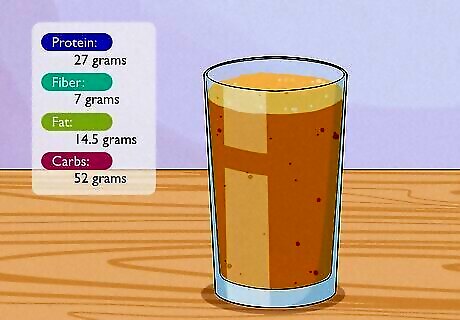
Pea Protein Smoothie According to personal trainer John Diaz, “pea protein is one of the better plant-based proteins available in a protein powder. Make it just like you’d make a whey protein shake, mixed with water or juice. You could even mix it into a Greek yogurt." For this pea protein smoothie, add a serving of the pea protein powder into a blender with 1 cup (237 mL) of your milk of choice, and a banana. Blend it up and enjoy a power shot of protein and fiber! Protein: 27 grams Fiber: 7 grams Fat: 14.5 grams Carbs: 52 grams How to Customize: Get even more protein with 1 tablespoon (15 grams) of peanut butter, or add fruit for a completely different flavor profile.
Veggie Omelet What tastes better in the A.M. than a bright, colorful veggie omelet? This one is super easy to make—just saute red onion and zucchini in some olive oil over medium heat. Add a total of 1 egg and ¾ cup (60 grams) of egg whites, plus some parmesan, salt, and pepper to season. Protein: 31 grams Fiber: 2 grams Fat: 13 grams Carbs: 10.5 grams How to Customize: Change or add any vegetables you like, from spinach and tomatoes to peppers and asparagus.
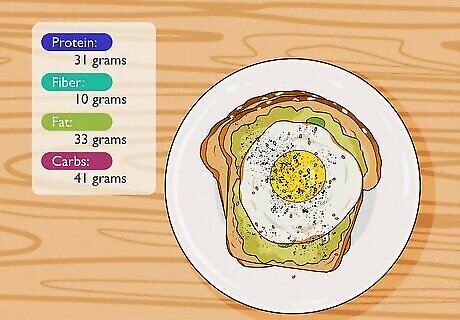
Avocado Toast Enjoy half an avocado combined with 1 cup (225 grams) of cottage cheese on 2 slices of multigrain bread. To boost your protein intake, top your avocado toast with a fried egg. Protein: 31 grams Fiber: 10 grams Fat: 33 grams Carbs: 41 grams How to Customize: Play with flavor in any way you like by adding seasonings like paprika, cumin, chili powder, oregano, or parsley.
Chia Seed Pudding Registered dietitian nutritionist Kelly Gomez says that chia seeds “are incredibly high in omega-3s and are also pretty high in fiber, even for just a couple of tablespoons." To make chia seed pudding, just add 2 tablespoons (20 grams) of chia seeds with ½ cup (118 mL) of almond or oat milk (or your milk of choice), and 1 tablespoon (20 grams) of honey. After storing in the fridge overnight, top it with your favorite fruit or nut topping! Protein: 5 grams Fiber: 9 grams Fat: 9 grams Carbs: 28 grams How to Customize: Top your chia seed pudding with more high-fiber nuts, like almonds, pistachios, or cashews, and high-fiber fruits like apples, pears, or berries. EXPERT TIP Kelly Gomez Kelly Gomez Registered Dietitian Nutritionist Kelly Gomez is a Registered Dietitian Nutritionist and Director of Nutrition Services at DexaBody. She specializes in helping clients understand the relationship between their nutritional choices and overall health. She has clinical experience working with clients who need meal plans, nutrition counseling, and sports nutrition information. Kelly is a member of the Academy of Nutrition and Dietetics and a member of the Collegiate and Professional Sports Dietitian Association (CPSDA). She has a Master of Science in nutrition science and a Bachelor's degree in kinesiology. Kelly Gomez Kelly Gomez Registered Dietitian Nutritionist Use whatever kind of milk you want with chia seed pudding. When chia seeds sit overnight, they absorb a lot of the milk and become pudding-like. It’s a really great, easy breakfast option for stay-at-home moms or anyone on the go who needs to get their fiber and some omega-3s.
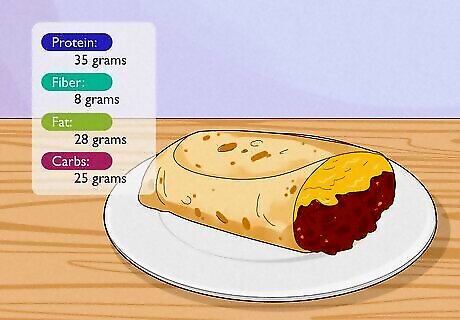
Breakfast Burrito You don’t need to order a breakfast burrito—instead, make a healthy breakfast at home! Brown your protein of choice (chicken sausage is a good protein source) over medium-high heat. Then, saute some peppers for a few minutes and whisk in eggs. Toss in some cream cheese cubes until they melt. Fill some corn tortillas with the egg mixture, the sausage, black beans, and shredded cheese. Bake the burritos in a 425 °F (218 °C) oven for about 10 minutes. Protein: 35 grams Fiber: 8 grams Fat: 28 grams Carbs: 25 grams How to Customize: Change your meat or protein choice by using pork sausage, ground turkey, or shredded chicken. Swap out the vegetables for others you like more, and go for red, white, or refried beans if you like.
Creamy Fruit Smoothie The classic fruit smoothie is a rich, delicious way to get your protein and fiber on the go. Blend the smoothie by starting with 1 cup (237 mL) of your milk of choice. Add in berries, a serving of Greek yoghurt, half a banana, a handful of rolled oats, and some chia seeds and honey for a breakfast that satisfies. Protein: 23 grams Fiber: 13 grams Fat: 10 grams Carbs: 58 grams How to Customize: Swap out regular milk with almond, oat, or coconut milk, and use cherries, peaches, or any other fruit you like. Certified nutrition & wellness consultant Lyssandra Guerra’s favorite smoothie recipe combines “spinach, baby kale, sesame paste/tahini, medjool dates, coconut water, and coconut cream.” To make it, she says to: “Add the greens to the blender, then the protein powder. Add 1-2 tbsp (15-30 grams) of tahini to the mix, along with 1 pitted medjool date, 12 ounces (355 mL) of coconut water, and 1 tbsp (15 grams) of coconut cream. The tahini creates a satisfying nutty flavor, while the medjool date, coconut water, and cream add natural sweetness.”
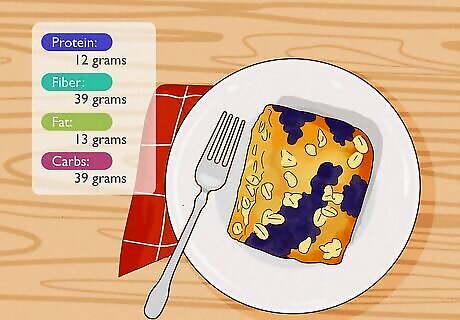
High-Protein Baked Oats Eating warm baked oatmeal when you first wake up is one of life’s great comforts. Getting enough protein and fiber is a bonus. Start with 2 cups (180 grams) of rolled oats and 2 cups (473 mL) of the milk of your choice, plus 2 eggs, a banana, and 1 teaspoon (4.79 grams) of baking powder. Toss in some Greek yoghurt, along with some cinnamon, walnuts, or chips. Bake at 375 °F (191 °C) for about 35 minutes. Protein: 12 grams Fiber: 39 grams Fat: 13 grams Carbs: 39 grams How to Customize: Sweeten with maple syrup, honey, or brown sugar, along with any fruit or nuts you like.
No-Bake Protein Balls These bite-sized breakfast treats are ideal when you don’t feel like turning on the oven. Combine 1 ½ cups (234 grams) of oats with 1 cup (240 grams) of peanut butter. Add ¼ cup (85 grams) of honey, ¼ cup (42 grams) of flax seeds, a dash of vanilla, 2 scoops of protein powder, and some chocolate chips. Roll them into balls and chill for 2 hours. Protein: 5 grams Fiber: 2 grams Fat: 9 grams Carbs: 14 grams How to Customize: Add in some dried fruits or nuts for even more of a protein and fiber boost.
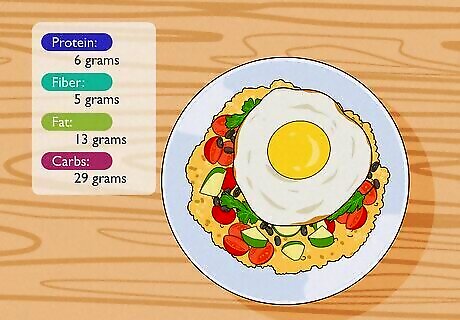
Quinoa Breakfast Bowl A great source of both protein and fiber, quinoa is popular at lunch and dinner, but did you know it can be used for a breakfast bowl? After preparing the quinoa with onion, garlic, and spices like paprika, coriander, and cumin, add them to a bowl. Toss in black beans, corn, cherry tomatoes, cilantro, avocado, and eggs. Dress the whole thing in olive oil, shallot, lemon juice, and honey dressing. Certified nutritionist John Burson includes quinoa bowls in his “body-friendly breakfast sensations” that promote good health. Protein: 6 grams Fiber: 5 grams Fat: 13 grams Carbs: 29 grams How to Customize: Prepare the eggs anyway you like (hard-boiled, scrambled, fried), or replace them with a breakfast sausage.
Raisin Nut Bran with Fruit The fastest way to fit in breakfast is likely finding a high-protein/high fiber cereal. A serving of Raisin Nut Bran alone has 7 grams of fiber and 5 grams of protein. The wheat and bran flakes, and crunchy almonds pair well with your favorite milk and some fruit for added nutrients. Protein: 7-8 grams Fiber: 7-8 grams Fat: 3.5 grams Carbs: 46-53 grams How to Customize: Vary the fruit you include with the cereal, sprinkle some cinnamon on top, or warm the milk for a comforting, hearty breakfast.
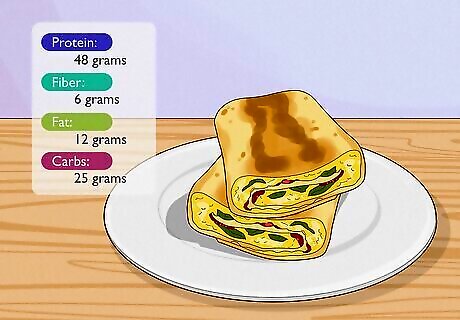
Spinach and Feta Breakfast Wrap To mimic your favorite Starbucks egg wrap, make an egg-whites-only omelet with spinach, sun-dried tomatoes, feta cheese, and seasonings. Wrap it up nice and tightly into a lavash-style wrap and enjoy. Protein: 48 grams Fiber: 6 grams Fat: 12 grams Carbs: 25 grams How to Customize: Add the meat of your choice for even more protein, or vary the veggies you use to suit your tastes.
Breakfast Bowl When you won’t accept anything less than breakfast in a bowl, this recipe is for you. Prepare an egg any style you like, plus some bacon (or turkey bacon) and hash browns. Top the bowl with sliced avocado, a dollop of Greek yoghurt, scallions, tomatoes, and cilantro. Protein: 20 grams Fiber: 1 gram Fat: 28 grams Carbs: 4 grams How to Customize: Change the way you prepare your eggs, change up the meat source, or add additional flavorings like Sriracha or hot sauce. Board-certified family medicine specialist Pouya Shafipour, MD, MS suggests that you’ll feel fuller for longer with options like “omelets, whole-grain granola with full-fat yogurt, raw nuts, and seeds, or a protein shake with milk or almond milk, chia seeds, flaxseed, and berries."
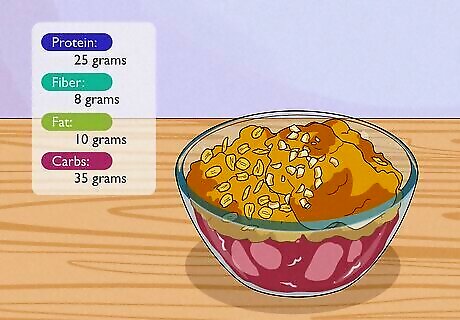
Berry Crumble Oatmeal Turn dessert into a healthy breakfast by combining frozen berries with a little jam and 1 teaspoon (2.5 grams) cornstarch as your crumble base. On top, combine rolled oats, protein powder, peanut butter, nuts, milk, cinnamon, salt, and maple syrup or honey. Bake at 325 °F (163 °C) for about 15 minutes. Protein: 25 grams Fiber: 8 grams Fat: 10 grams Carbs: 35 grams How to Customize: Replace the protein powder with a high-protein flour, like oat flour or almond flour.
Chickpea Curry Chickpeas are a super food when it comes to protein and fiber. Go for a savory Indian-inspired breakfast like this curry—you might want it again at dinnertime. Sauté onion, garlic, and ginger with curry powder, masala, curry, and cumin flakes. Add 2 cans of chickpeas, along with a can of crushed tomatoes and one of coconut milk. Toss in some baby spinach, lime juice, and cilantro, and serve on toast. Protein: 9 grams Fiber: 10 grams Fat: 27 grams Carbs: 33 grams How to Customize: Play with your spices. If you prefer a creamier texture, add more coconut milk; alternatively, use chicken stock for a less creamy consistency.
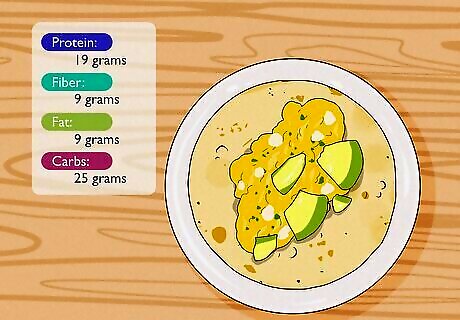
Tofu Scramble If you’re sick of thinking up interesting egg recipes to get your protein and/or fiber, replace eggs with tofu. Prepare the tofu with spices (and nutritional yeast), and scramble it up with onions, garlic, peppers, beans, and spinach. Serve on toast or tortillas. Protein: 19 grams Fiber: 9 grams Fat: 9 grams Carbs: 25 grams How to Customize: Serve with avocado or cilantro for a fresh twist, or sprouts, tomatoes, sriracha, or basil.
Spinach & Fried Egg Grain Bowls Combine a healthy egg and veggie breakfast with a satisfying grain bowl. Grain bowls typically feature a type of grain, accompanied by a protein and a vegetable source. This one combines eggs, farro, scallions, garlic, spinach, feta, and olives for a Mediterranean bowlful of flavor. Protein: 15 grams Fiber: 8 grams Fat: 15 grams Carbs: 40 grams How to Customize: Clinical nutritionist Tara Coleman recommends "adding nut butter, hemp hearts, or whole nuts” to your grain bowl.
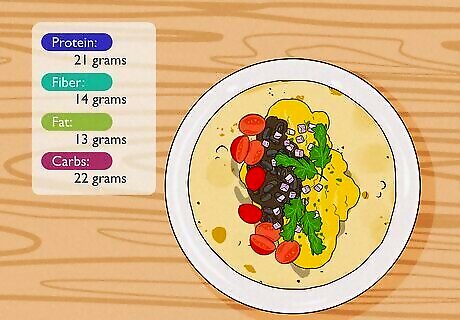
Breakfast Tostada For this easy morning pick-me-up, prepare an egg (or egg white) omelet until scrambled. Add beans to the eggs, and serve on a tortilla with avocado, tomato, and onion. Protein: 21 grams Fiber: 14 grams Fat: 13 grams Carbs: 22 grams How to Customize: Experiment with your toppings, or choose a different kind of bean for your tostada.
High Protein Muesli Like Muesli cereal, which is made from grains, seeds, nuts, and dried fruit, homemade Muesli is a combination of cereal and overnight oats. Combine 2 cups (180 grams) of rolled oats with 3 cups (710 mL) of any milk of your choice. Add in chia seeds, pumpkin seeds, currants, and coconut flakes. Refrigerate it overnight and top with more fruits, nuts, and seeds you enjoy. Protein: 9 grams Fiber: 6 grams Fat: 15 grams Carbs: 32 grams How to Customize: Make it zestier with some cinnamon and spices, or add a dollop of Greek yoghurt on top.
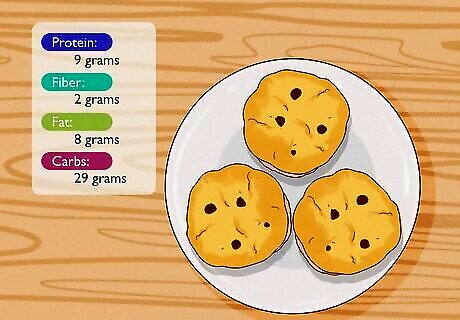
Banana Protein Oat Muffins Who says you can’t have healthy muffins? These babies use oat flour to fill you up, along with mashed bananas, eggs, peanut butter, maple syrup, and vanilla extract. You can even add in chocolate chips or dried fruit before baking for 15 minutes at 350 °F (177 °C). Protein: 9 grams Fiber: 2 grams Fat: 8 grams Carbs: 29 grams How to Customize: Add in anything you like, from nuts and seeds to coconut flakes.
Crunchy Protein Granola There is no need to spend money on store-bought granola when you can easily prepare granola at home. Starting with 3 cups (468 grams) of old-fashioned oats, add walnuts, almonds, and pistachios. To this add vanilla protein powder, cinnamon, salt, vanilla, honey, and oil. Bake it for about 20 minutes in a 325 °F (163 °C) oven. Protein: 12 grams Fiber: 5 grams Fat: 10 grams Carbs: 40 grams How to Customize: Swap out honey for maple syrup if preferred, and get creative with the nuts, seeds, or dried fruits you add.
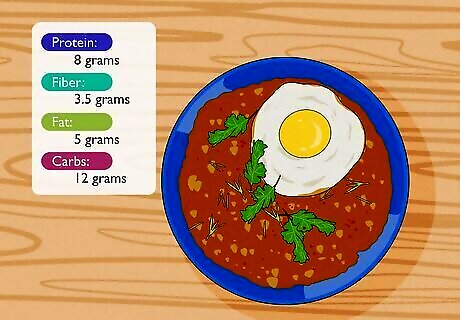
White Bean Shakshuka It’s simple to turn a trendy shakshuka recipe into a high-protein, high-fiber breakfast with the help of cannellini beans. After sauteing onions, peppers, garlic, and spices like coriander, cumin, paprika, and Aleppo pepper, all that’s left to add are canned diced tomatoes, cannellini beans, eggs, parsley, and dill. Protein: 8 grams Fiber: 3.5 grams Fat: 5 grams Carbs: 12 grams How to Customize: Use whatever bean you like the most, and add or replace veggies. Use spinach, asparagus, or Swiss chard for your own take on shakshuka.
Sourdough Waffles with Protein Like any waffle mix, making this batter consists of adding the wet ingredients to the dry ones. Sourdough lovers will enjoy using their discarded sourdough to add nutrients to this breakfast. Protein powder offers just the right amount of flavor for waffles that are actually good for you. Protein: 22 grams Fiber: 1 gram Fat: 5 grams Carbs: 37 grams How to Customize: Add any toppings you want to, from fresh or dried fruit or nuts to dark chocolate chips.
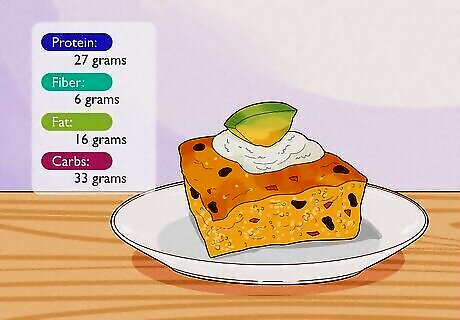
25 Quinoa Breakfast Bake This recipe combines the ease of a casserole with the healthy, high-protein found in quinoa. Black beans, bell peppers, and Mexican cheese provide the flavor, while the eggs and cottage cheese make the dish creamy and packed with protein and fiber. Protein: 27 grams Fiber: 6 grams Fat: 16 grams Carbs: 33 grams How to Customize: Change up the flavor profile with corn, onions, or diced green chiles. Serve with some Greek yoghurt or sliced avocado if you like.
Breakfast Beans and Eggs What could be easier than preparing eggs and beans for breakfast, along with the multigrain toast of your choice? Jazz up your white beans with cherry tomatoes, garlic, oregano, and thyme to serve alongside some freshly scrambled eggs. Protein: 24 grams Fiber: 8 grams Fat: 17 grams Carbs: 39 grams How to Customize: Add other flavors you like to your beans, like spinach or peppers. Prepare the eggs anyway you like most, and add some avocado into the mix.
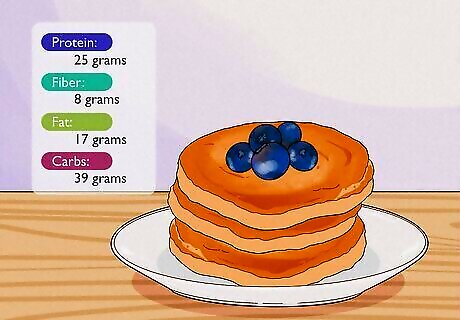
High-Protein Blueberry Pancakes These pancakes are not only high in fiber and protein, but they’re also gluten-free (and delicious). Their flavor comes from buttermilk, cottage cheese, cinnamon, vanilla, and blueberries. The oats provide the nutrients and a rich texture to the pancakes. Protein: 25 grams Fiber: 2 grams Fat: 10 grams Carbs: 19 grams How to Customize: Add other fresh fruits to the pancakes, like raspberries or blueberries, or even dark chocolate chips. Certified dietician-nutritionist Lisa Jubilee says, “The best low-carb flours to use for pancakes are almond, coconut, or cassava; then, add eggs, a fat source like butter or ghee, a natural no-calorie sweetener like stevia or monk fruit, a leavening agent such as baking soda, a liquid, which can be water, milk, or a non-dairy beverage, and vanilla extract for flavor."
Smoked Salmon Bagel If you’re craving salmon and cream cheese on a bagel in the morning, this recipe is for you. Replace traditional bagels with thin versions, and add pickled cucumbers and arugula for a fresh, tasty treat that offers you 30 grams of protein at breakfast. Protein: 35 grams Fiber: 6 grams Fat: 24 grams Carbs: 30 grams How to Customize: Add more protein with eggs, or alter the flavors using tomatoes, gherkins, or olives.
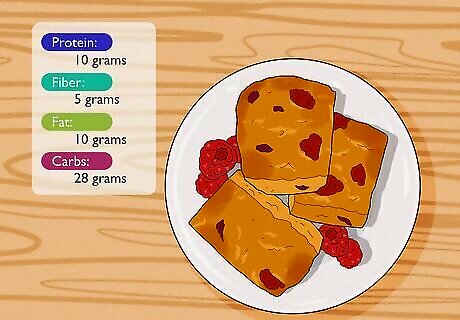
Breakfast Bars Replace the often sugar-filled protein bars you might buy with healthier options at home. All you’ll need is peanut butter, bananas, oatmeal, eggs, and maple syrup or honey, along with chia seeds, flour, and baking powder. Add nuts and berries for a flavor you’ll love waking up to. Because they’re baked, you can enjoy these bars warm. Protein: 10 grams Fiber: 5 grams Fat: 10 grams Carbs: 28 grams How to Customize: Use whatever berries or dried fruits you like, or add different varieties of nuts or raisins to make this recipe your own.
Green Smoothie The best part about this green smoothie recipe is that you can prepare the ingredients and keep them stored together in the freezer until you’re ready to blend them. Ingredients like pineapple juice, green apple, spinach leaves, and pear are packed with nutrients, while vanilla protein powder and avocado offer your smoothie plenty of protein and good fats (and a creamy finish). Protein: 24 grams Fiber: 12 grams Fat: 19 grams Carbs: 49 grams How to Customize: Add a banana for even more creaminess in your smoothie, peanut butter, or Greek yoghurt.
Foods That Are High in Protein
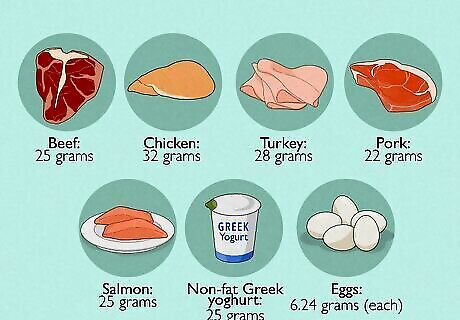
Animal sources Animal nutrition sources with the highest amount of protein include lean meats like beef, chicken, turkey, and pork. The highest protein seafoods include salmon, tuna, and shrimp, along with eggs and dairy products like milk, yoghurt, and cheese. More examples are ahead: Beef: 25 grams Chicken: 32 grams Turkey: 28 grams Pork: 22 grams Salmon: 25 grams Non-fat Greek yoghurt: 10.3 grams Eggs: 6.24 grams (each) Amounts of protein are per 3.5 oz or 100 grams.
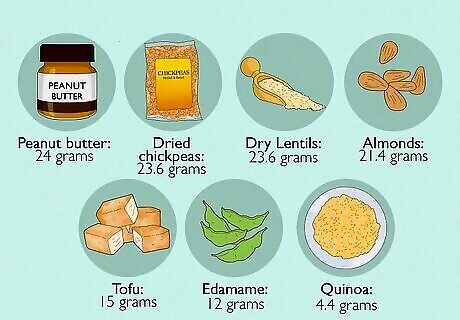
Plant sources Plant-based sources of protein are mostly found in legumes, which include nuts, seeds, tofu/tempeh, and quinoa. Quinoa is a great meat-free option that can be used at breakfast, lunch, or dinner in a multitude of ways. Some examples are here: Peanut butter: 24 grams Dried chickpeas: 24.3 grams Dry lentils: 23.6 grams Almonds: 21.4 grams Tofu: 15 grams Edamame: 12 grams Quinoa: 4.4 grams Amounts of protein are per 3.5 oz or 100 grams.
Foods That Are High in Fiber
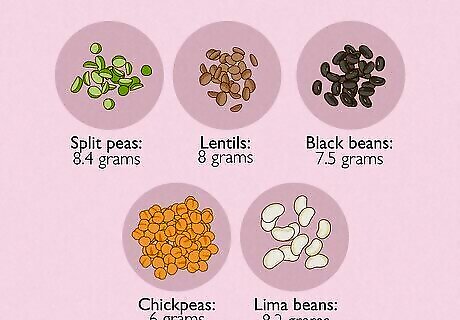
Legumes While many legumes are high in protein, they’re also a great source of fiber. Beans, lentils, and peas are loaded with soluble and insoluble fiber, which promotes weight management, digestive health, heart health, and stable blood sugar. A more detailed breakdown can be found ahead: Split peas: 8.2 grams Lentils: 8 grams Black beans: 7.5 grams Chickpeas: 6 grams Lima beans: 6 grams Amounts of fiber are per 4-oz or 113-gram serving.
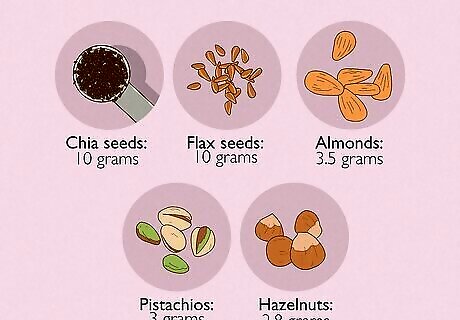
Seeds & nuts Seeds and nuts are also a good source of protein, especially when you’re not eating meat. You can easily add them to many breakfast options, including oatmeal, breakfast bars, or yoghurt bowls. How nuts and seeds shake out is listed here: Chia seeds: 10 grams Flax seeds: 10 grams Almonds: 3.5 grams Pistachios: 3 grams Hazelnuts: 2.8 grams Amounts of fiber are per 1-oz or 28-gram serving.
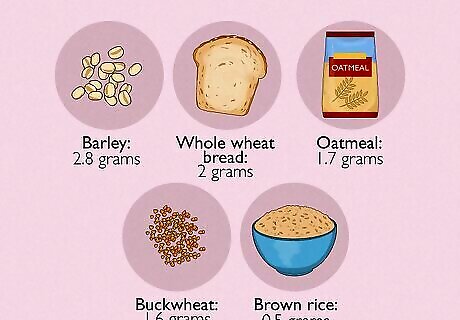
Whole grains It’s not necessary to cut out carbohydrates (or even gluten) altogether when prioritizing fiber. Whole grains contain more nutrients than overly-refined or processed grains do. Some of the top fiber choices among whole grains are ahead: Barley: 2.8 grams Whole wheat bread: 2 grams Oats: 1.7 grams Buckwheat: 1.6 grams Brown rice: 0.5 grams Amounts of fiber are per half an ounce or 16-gram serving.
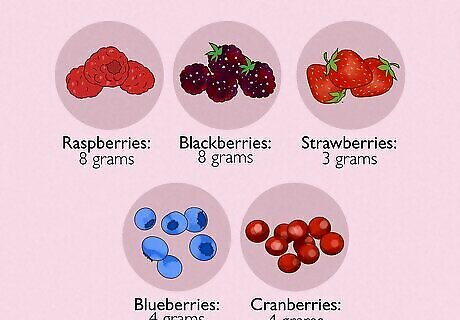
Berries Berries are typically high in fiber and are known for containing antioxidants as well. They make a tasty addition to a breakfast yoghurt parfait or on top of cereal or oatmeal. Berries can also make any smoothie even more flavorful with their naturally sweet taste. The fiber content in popular berries is here: Raspberries: 8 grams Blackberries: 8 grams Strawberries: 3 grams Blueberries: 4 grams Cranberries: 4 grams Amounts of fiber are per 8-oz or 227-gram serving.
How much protein & fiber should you eat for breakfast?
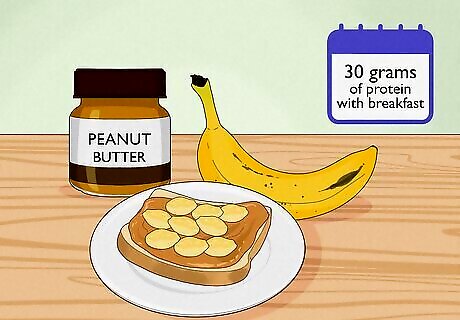
It’s recommended to eat 30 grams of protein with breakfast. To ease yourself into the practice, certified nutritionist Nimisha Gandhi suggests that, "instead of skipping meals or just going straight for coffee or tea in the morning, try to have 20 grams of protein, 1 serving of healthy fats, and some carbohydrates. It will help balance out your insulin for the rest of the day, reduce cravings, and give you energy and stamina." The minimum recommended daily amount of protein for an average adult to stay healthy is 0.8 grams per kilogram of body weight. The daily amount of protein you need depends on your age, your overall health, and how active you are. It can range from 140 grams of daily protein for an active person to getting 250 grams of protein a day for meal-prepping bodybuilders who want to bulk up.
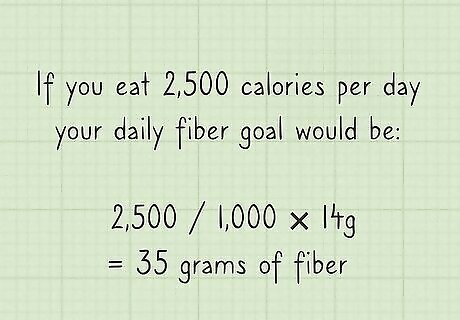
It’s advised to consume 14 grams of fiber daily for every 1,000 calories. This amount usually adds up to between 25 to 38 grams of fiber daily for adults, according to The Institute of Medicine (IOM). Generally, women should consume closer to 25 grams of fiber daily, while men should consume closer to 38 grams of fiber. To calculate your daily recommended amount of fiber, use an online fiber calculator. For a basic calculation, here is an example: If you eat 2,500 calories per day, your daily fiber goal would be: 2,500 / 1,000 × 14g = 35 grams of fiber.
Benefits of a High-Protein, High-Fiber Diet

Weight loss Higher amounts of both protein and fiber at breakfast can help you feel fuller and more satiated for longer throughout your day. You may be less likely to overeat, which could lead to weight loss, if part of a healthy diet with regular exercise. Dr. Shafipour believes that “a healthy breakfast can include a combination of complex carbohydrates, fat, and protein that provides sustained energy levels and avoids rapid rise and fall of blood glucose, which can result in hunger."
Improved digestive health Fiber in particular helps move food through the digestive system and creates more bulk in your stool. This can help prevent constipation and promote a healthy gut.

Preserving muscle A high-protein, high-fiber diet is associated with preserving muscle, because of a reduction in fat mass and an increase in lean mass. This is especially true for older adults who are concerned about age-related declines in muscle mass.
Maintain blood sugar Proteins have been associated with slowing down the release of sugars into the bloodstream, which helps keep your blood sugar level at a normal, desired range. For whole grains, fiber acts like an outer shell that also delays the flow of sugar into the bloodstream, which can help with cholesterol or chronic disease prevention.
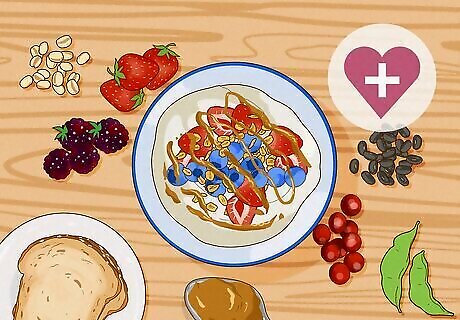
Improve heart health Foods with soluble fiber have been known to lower LDL (or “bad”) cholesterol and aid in lowering blood pressure. Lean proteins found in fish and nuts, in particular, include omega-3s and other heart-healthy nutrients. These factors can keep your heart health going strong while you eat healthy every morning.
Tips For Increasing Your Protein And/or Fiber Intake
Balance your meals and add protein and/or fiber when possible. If you enjoy a breakfast grain bowl, bump up your protein levels with an additional egg or lean meat like turkey bacon. Morris says her preferred protein sources include “eggs (preferably whites), chicken sausage, nonfat or low-fat Greek yogurt or cottage cheese, and various nuts.” For added fiber, she likes “whole grain oats (overnight or steel cut is best), whole-grain tortillas, yams/sweet potatoes, spinach, berries, chia and flaxseeds, quinoa, [and] beans.” More detailed tips include: Add protein supplements like protein powder to everything from smoothies and breakfast bars to pancake and waffle batter. Balance your meals, so you’re not getting all of your daily intake of protein or fiber in one place. Bulk up with added protein found in eggs, Greek yoghurt, nuts, seeds, or beans. Eat more fruits, vegetables, & legumes, which are packed with protein and fiber, along with antioxidants in the case of berries. Include animal proteins like lean beef, poultry, or fish. Salmon is a great source of protein with 25 grams of protein in each 3.5-oz or 100-gram serving, in addition to healthy fats and minerals. Eat proteins before carbs so your body digests the carbohydrates more slowly, which can make you feel fuller. Take a fiber supplement to help control blood sugar and maintain a healthy gut. Drink plenty of water (8-10 glasses a day) to prevent gas or bloating from occurring.














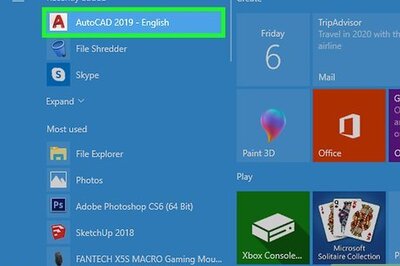


Comments
0 comment